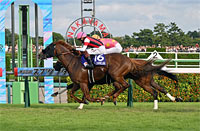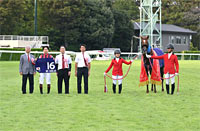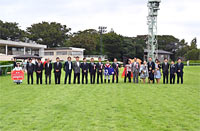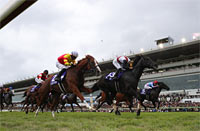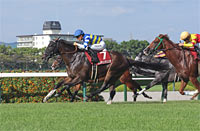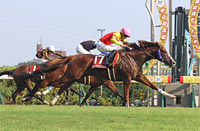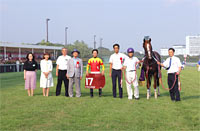Sprinters Stakes (G1) - Data Analysis
Autumn sprint decider
The Sprinters Stakes is a highly anticipated race by virtue of being the autumn sprint decider and the first G1 race of the autumn season. Over the last six years, the race has produced a flurry of surprises with race favorites notching four victories on the one hand, and runners backed as 11th favorite or lower delivering five Top 3 finishers on the other. Let’s now look for some trends in this race based on results for the last 10 years (including the 2014 race held at Niigata Racecourse) or the last 10 races held at Nakayama Racecourse.
Focus on runners that have not suffered major defeats in previous two races
Looking at performances by runners over the last 10 years in terms of their lowest finish in their two previous races, we find that runners with a lowest finish of 4th or higher in such races produced the highest success ratios. Although runners that had suffered a major defeat in their two previous races also often delivered strong performance, if we limit our analysis to the last seven races held at Nakayama Racecourse since 2011, we find that all winners had a lowest finish of 4th or higher in their two previous races. In other words, we should focus on runners with strong performances in their two previous races. [Table 1]
[Table 1] Performance by lowest finish in previous two races (last 10 years)
| Lowest finish |
Performance
[1st-2nd-3rd-4th or lower] |
Win ratio |
Top 2 ratio |
Top 3 ratio |
| 1st |
2-2-2-9 |
13.3% |
26.7% |
40.0% |
| 2nd |
2-1-1-12 |
12.5% |
18.8% |
25.0% |
| 3rd |
1-2-1-10 |
7.1% |
21.4% |
28.6% |
| 4th |
2-1-2-6 |
18.2% |
27.3% |
45.5% |
| 5th |
0-0-1-9 |
0% |
0% |
10.0% |
| 6th-9th |
1-1-2-41 |
2.2% |
4.4% |
8.9% |
| 10th or lower |
2-3-1-43 |
4.1% |
10.2% |
12.2% |
Check favoritism in recent JRA turf 1,200m graded race
Looking at performances by runners over the last 10 years in terms of their favoritism in a recent JRA turf 1,200m graded race, we note that runners backed as 4th favorite or higher in such a race produced nine of the 10 winners and 18 of the 20 Top 2 finishers. Conversely, runners backed as 5th favorite or lower in a recent JRA turf 1,200m graded race produced a much lower number of Top 3 finishers and had sharply lower success ratios. Incidentally, Hong Kong-trained Ultra Fantasy triumphed in the 2010 Sprinters Stakes (his JRA debut) without having contested a recent JRA turf 1,200m graded race. Among Japanese runners, however, we should raise our expectations of runners that were highly favored in a recent JRA turf 1,200m graded race. [Table 2]
[Table 2] Performance by favoritism in recent JRA turf 1,200m graded race (last 10 years)
| Favoritism |
Performance
[1st-2nd-3rd-4th or lower] |
Win ratio |
Top 2 ratio |
Top 3 ratio |
| 1st favorite |
5-2-1-18 |
19.2% |
26.9% |
30.8% |
| 2nd favorite |
0-5-3-13 |
0% |
23.8% |
38.1% |
| 3rd favorite |
2-1-0-20 |
8.7% |
13.0% |
13.0% |
| 4th favorite |
2-1-2-11 |
12.5% |
18.8% |
31.3% |
| 5th favorite |
0-0-0-9 |
0% |
0% |
0% |
| 6th-9th favorite |
0-0-4-35 |
0% |
0% |
10.3% |
| 10th favorite or lower |
0-1-0-14 |
0% |
6.7% |
6.7% |
| No such race entered |
1-0-0-10 |
9.1% |
9.1% |
9.1% |
Check number of races entered since May of the same year
Looking at performances by runners over the last 10 years in terms of the number of races entered since May of the same year, we observe that nine of the 10 winners had entered two races, and the remaining winner one race. In addition, 17 of the 20 Top 2 finishers had entered two or fewer races, while runners that had entered three or more races tended to struggle. We should therefore check the pre-race schedule of this year’s runners. [Table 3]
[Table 3] Performance by number of races entered since May of the same year (last 10 years)
| Number of races |
Performance
[1st-2nd-3rd-4th or lower] |
Win ratio |
Top 2 ratio |
Top 3 ratio |
| 4 or more |
0-1-3-21 |
0% |
4.0% |
16.0% |
| 3 |
0-2-3-40 |
0% |
4.4% |
11.1% |
| 2 |
9-2-4-34 |
18.4% |
22.4% |
30.6% |
| 1 |
1-3-0-29 |
3.0% |
12.1% |
12.1% |
| 0 |
0-2-0-6 |
0% |
25.0% |
25.0% |
Runners with numbers 6 or above produce many winners
Looking at performances by runners in the last 10 races held at Nakayama Racecourse (excluding the 2014 race held at Niigata Racecourse) by horse number, we find that nine of the 10 winners entered the race with numbers 6 or above. Runners with numbers “6-10” and “11-16” achieved higher win and Top 2 ratios than runners with numbers “1-5.” In addition, runners with numbers “1-5” produced five third-place finishers, and there were no major differences in Top 3 ratios by barrier draw (inner, middle, or outer). These could be considered useful statistics when planning bet formations. [Table 4]
[Table 4] Performance by horse number (last 10 races held at Nakayama Racecourse)
| Horse number |
Performance
[1st-2nd-3rd-4th or lower] |
Win ratio |
Top 2 ratio |
Top 3 ratio |
| 1-5 |
1-3-5-41 |
2.0% |
8.0% |
18.0% |
| 6-10 |
5-3-2-39 |
10.2% |
16.3% |
20.4% |
| 11-16 |
4-4-3-48 |
6.8% |
13.6% |
18.6% |
Seek out the winner!
Runners that have won close contests in recent races are strong performers
Looking at performances by the winners of the last five Sprinters Stakes (excluding the 2014 race held at Niigata Racecourse) in terms of time difference with the runner-up in a race they won in their last three outings, we note that the time difference for each of the winners was 0.1s or less. In other words, we should focus on runners that won a close contest in a recent race. [Table 5]
[Table 5] Winners that won a race with a time difference of 0.1s or less with the runner-up in their last three outings (last five races excluding the 2014 race held at Niigata Racecourse)
| Year |
Winner |
Race in question |
| 2013 |
Lord Kanaloa |
Yasuda Kinen (no time difference) |
| 2015 |
Straight Girl |
Victoria Mile (no time difference) |
| 2016 |
Red Falx |
CBC Sho, Keyaki Stakes (no time difference in either race) |
| 2017 |
Red Falx |
Keio Hai Spring Cup (0.1s time difference) |
| 2018 |
Fine Needle |
Takamatsunomiya Kinen (no time difference) |
(Michio Kawano)
|















